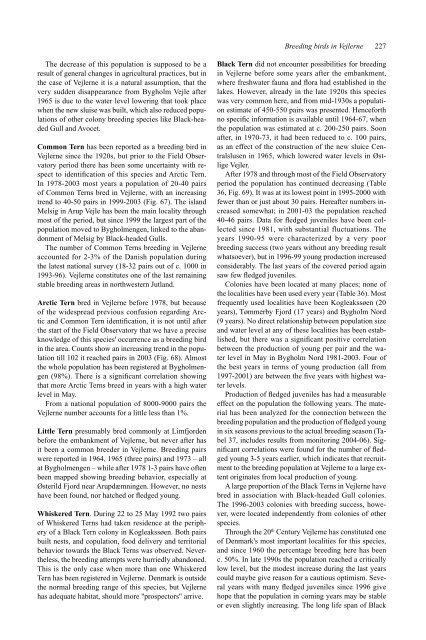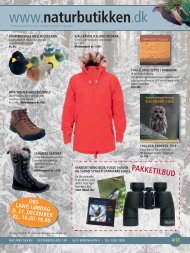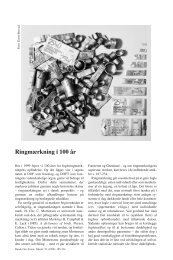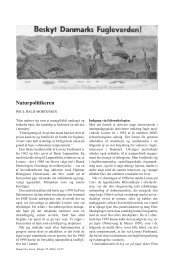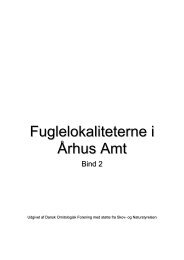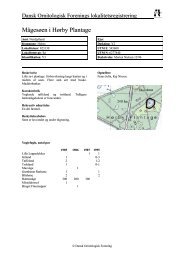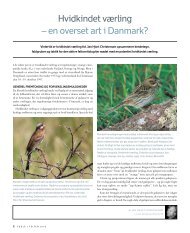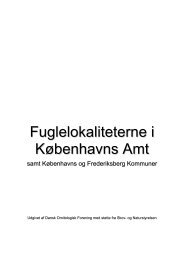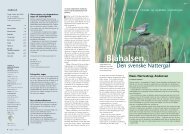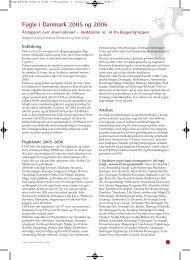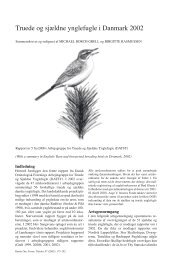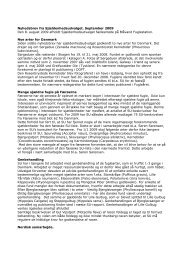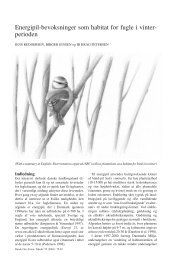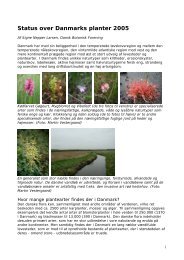Ynglefugle i Vejlerne - Dansk Ornitologisk Forening
Ynglefugle i Vejlerne - Dansk Ornitologisk Forening
Ynglefugle i Vejlerne - Dansk Ornitologisk Forening
Create successful ePaper yourself
Turn your PDF publications into a flip-book with our unique Google optimized e-Paper software.
The decrease of this population is supposed to be a<br />
result of general changes in agricultural practices, but in<br />
the case of <strong>Vejlerne</strong> it is a natural assumption, that the<br />
very sudden disappearance from Bygholm Vejle after<br />
1965 is due to the water level lowering that took place<br />
when the new sluise was built, which also reduced populations<br />
of other colony breeding species like Black-headed<br />
Gull and Avocet.<br />
Common Tern has been reported as a breeding bird in<br />
<strong>Vejlerne</strong> since the 1920s, but prior to the Field Observatory<br />
period there has been some uncertainty with respect<br />
to identication of this species and Arctic Tern.<br />
In 1978-2003 most years a population of 20-40 pairs<br />
of Common Terns bred in <strong>Vejlerne</strong>, with an increasing<br />
trend to 40-50 pairs in 1999-2003 (Fig. 67). The island<br />
Melsig in Arup Vejle has been the main locality through<br />
most of the period, but since 1999 the largest part of the<br />
population moved to Bygholmengen, linked to the abandonment<br />
of Melsig by Black-headed Gulls.<br />
The number of Common Terns breeding in <strong>Vejlerne</strong><br />
accounted for 2-3% of the Danish population during<br />
the latest national survey (18-32 pairs out of c. 1000 in<br />
1993-96). <strong>Vejlerne</strong> constitutes one of the last remaining<br />
stable breeding areas in northwestern Jutland.<br />
Arctic Tern bred in <strong>Vejlerne</strong> before 1978, but because<br />
of the widespread previous confusion regarding Arctic<br />
and Common Tern identication, it is not until after<br />
the start of the Field Observatory that we have a precise<br />
knowledge of this species' occurrence as a breeding bird<br />
in the area. Counts show an increasing trend in the population<br />
till 102 it reached pairs in 2003 (Fig. 68). Almost<br />
the whole population has been registered at Bygholmengen<br />
(98%). There is a signicant correlation showing<br />
that more Arctic Terns breed in years with a high water<br />
level in May.<br />
From a national population of 8000-9000 pairs the<br />
<strong>Vejlerne</strong> number accounts for a little less than 1%.<br />
Little Tern presumably bred commonly at Limfjorden<br />
before the embankment of <strong>Vejlerne</strong>, but never after has<br />
it been a common breeder in <strong>Vejlerne</strong>. Breeding pairs<br />
were reported in 1964, 1965 (three pairs) and 1973 – all<br />
at Bygholmengen – while after 1978 1-3 pairs have often<br />
been mapped showing breeding behavior, especially at<br />
Østerild Fjord near Arupdæmningen. However, no nests<br />
have been found, nor hatched or edged young.<br />
Whiskered Tern. During 22 to 25 May 1992 two pairs<br />
of Whiskered Terns had taken residence at the periphery<br />
of a Black Tern colony in Kogleakssøen. Both pairs<br />
built nests, and copulation, food delivery and territorial<br />
behavior towards the Black Terns was observed. Nevertheless,<br />
the breeding attempts were hurriedly abandoned.<br />
This is the only case when more than one Whiskered<br />
Tern has been registered in <strong>Vejlerne</strong>. Denmark is outside<br />
the normal breeding range of this species, but <strong>Vejlerne</strong><br />
has adequate habitat, should more "prospectors" arrive.<br />
Breeding birds in <strong>Vejlerne</strong> 227<br />
Black Tern did not encounter possibilities for breeding<br />
in <strong>Vejlerne</strong> before some years after the embankment,<br />
where freshwater fauna and ora had established in the<br />
lakes. However, already in the late 1920s this species<br />
was very common here, and from mid-1930s a population<br />
estimate of 450-550 pairs was presented. Henceforth<br />
no specic information is available until 1964-67, when<br />
the population was estimated at c. 200-250 pairs. Soon<br />
after, in 1970-73, it had been reduced to c. 100 pairs,<br />
as an effect of the construction of the new sluice Centralslusen<br />
in 1965, which lowered water levels in Østlige<br />
Vejler.<br />
After 1978 and through most of the Field Observatory<br />
period the population has continued decreasing (Table<br />
36, Fig. 69). It was at its lowest point in 1995-2000 with<br />
fewer than or just about 30 pairs. Hereafter numbers increased<br />
somewhat; in 2001-03 the population reached<br />
40-46 pairs. Data for edged juveniles have been collected<br />
since 1981, with substantial fluctuations. The<br />
years 1990-95 were characterized by a very poor<br />
breeding success (two years without any breeding result<br />
whatsoever), but in 1996-99 young production increased<br />
considerably. The last years of the covered period again<br />
saw few edged juveniles.<br />
Colonies have been located at many places; none of<br />
the localities have been used every year (Table 36). Most<br />
frequently used localities have been Kogleakssøen (20<br />
years), Tømmerby Fjord (17 years) and Bygholm Nord<br />
(9 years). No direct relationship between population size<br />
and water level at any of these localities has been established,<br />
but there was a signicant positive correlation<br />
between the production of young per pair and the water<br />
level in May in Bygholm Nord 1981-2003. Four of<br />
the best years in terms of young production (all from<br />
1997-2001) are between the ve years with highest water<br />
levels.<br />
Production of edged juveniles has had a measurable<br />
effect on the population the following years. The material<br />
has been analyzed for the connection between the<br />
breeding population and the production of edged young<br />
in six seasons previous to the actual breeding season (Tabel<br />
37, includes results from monitoring 2004-06). Signicant<br />
correlations were found for the number of edged<br />
young 3-5 years earlier, which indicates that recruitment<br />
to the breeding population at <strong>Vejlerne</strong> to a large extent<br />
originates from local production of young.<br />
A large proportion of the Black Terns in <strong>Vejlerne</strong> have<br />
bred in association with Black-headed Gull colonies.<br />
The 1996-2003 colonies with breeding success, however,<br />
were located independently from colonies of other<br />
species.<br />
Through the 20 th Century <strong>Vejlerne</strong> has constituted one<br />
of Denmark's most important localities for this species,<br />
and since 1960 the percentage breeding here has been<br />
c. 50%. In late 1990s the population reached a critically<br />
low level, but the modest increase during the last years<br />
could maybe give reason for a cautious optimism. Several<br />
years with many edged juveniles since 1996 give<br />
hope that the population in coming years may be stable<br />
or even slightly increasing. The long life span of Black


